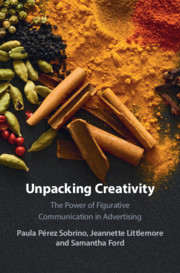Book contents
- Unpacking Creativity
- Unpacking Creativity
- Copyright page
- Dedication
- Contents
- Figures
- Tables
- Acknowledgements
- Introduction
- Part I Theoretical Perspectives
- Part II Empirical Studies
- 5 Spiderman or Devil Horns?
- 6 If It’s Red It Must Be Sport
- 7 Curry Is Yellow in Japan but Orange in the US
- 8 So Real It’s Scary
- 9 Cross-Cultural and Gender-Based Variation in the Emotional Impact and Appreciation of Marketing Videos
- 10 Having Fun with His Custard Factory?
- 11 What Do We Now Know About the Creative use of Figurative Communication in Advertising?
- Notes
- Appendix
- References
- Secondary References
- Index
5 - Spiderman or Devil Horns?
The Impact of Figurative and Visual Complexity and Viewing Times on People’s Responses to Advertisements
from Part II - Empirical Studies
Published online by Cambridge University Press: 14 August 2021
- Unpacking Creativity
- Unpacking Creativity
- Copyright page
- Dedication
- Contents
- Figures
- Tables
- Acknowledgements
- Introduction
- Part I Theoretical Perspectives
- Part II Empirical Studies
- 5 Spiderman or Devil Horns?
- 6 If It’s Red It Must Be Sport
- 7 Curry Is Yellow in Japan but Orange in the US
- 8 So Real It’s Scary
- 9 Cross-Cultural and Gender-Based Variation in the Emotional Impact and Appreciation of Marketing Videos
- 10 Having Fun with His Custard Factory?
- 11 What Do We Now Know About the Creative use of Figurative Communication in Advertising?
- Notes
- Appendix
- References
- Secondary References
- Index
Summary
Chapter 5 reports findings from a study which explores the impact of viewing time on people’s responses to metaphor and metonymy when used alone and in combination, and when presented with varying degrees of visual complexity. The study addresses the following question: Do people appreciate a simple but enigmatic metaphoric image, or do they prefer a detailed image containing plenty of cues as to the intended figurative meaning of the advertisement? In other words: Do people prefer schematic or content rich figurative advertisements? The findings from the study show that viewers are most likely to find advertisements that contain metaphor and that are content-rich to be more engaging. Metaphor is even more likely to be appreciated when it is presented in a content-rich design. Persuasiveness ratings for both metaphor and metonymy increase when people are given longer to view the advertisement. The meanings that people identify in advertisements are strongly shaped by their personal interests and their levels of familiarity with the product, which are in turn sometimes mediated by nationality and gender. Need for cognition affects people’s ability to find meaning in advertisements containing metaphor and metonymy.
Keywords
- Type
- Chapter
- Information
- Unpacking CreativityThe Power of Figurative Communication in Advertising, pp. 91 - 125Publisher: Cambridge University PressPrint publication year: 2021

